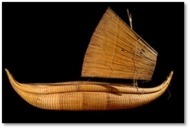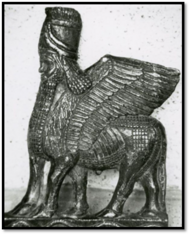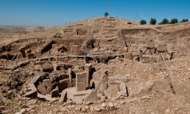Chapter 2
Ancient connections across oceans

Another very strange coincidence concerns the people who live on Lake Titicaca. These people are known as the Uru or Uros people, and they inhabit floating islands, built from reeds, they also still make houses and boats from reeds, What I find very strange is the fact that their reed boats are almost identical to those made by early Sumerians of Mesopotamia.
Can it be mere coincidence that the earliest cities in Mesopotamia are called Ur and Uruk, with no connection to the Uru people? To stretch coincidence a little more, there are still people living in southern Iraq who live on floating islands and build houses from reeds to this day. To add a little to the coincidence, the early Egyptians also made boats from reeds. Add to that, the Uru people regard themselves as “children of the sun”, which sounds quite similar to ancient Egyptian traditions. It begins to look like “a small world” in ancient times.
Everything mentioned so far in this section is not controversial, and can be easily confirmed in a few minutes on the internet. There are additional items which seemingly connect the Middle East area to South America. There is the controversial “Fuente magna” bowl, which is reputed to have “proto Sumerian” writing on the inside.
Everything mentioned so far in this section is not controversial, and can be easily confirmed in a few minutes on the internet. There are additional items which seemingly connect the Middle East area to South America. There is the controversial “Fuente magna” bowl, which is reputed to have
“proto Sumerian” writing on the inside.
This bowl is said to have been found by a local farmer, not far from Lake Titicaca. Some have said it is a fake artefact, I am not so sure. A scholar by the name of Clyde Winters has apparently deciphered the writing, others say it is not at all connected to Sumerian.
Other strange artefacts from Ecuador, come from a collection by a priest known as “father Crespi”. Much controversy surrounds the Crespi collection, and most of the collection has disappeared since his death.
This collection was made famous by the books of Erich von Daniken (Chariots of the Gods). Von Daniken’s books are themselves quite controversial, and many scholars go to some lengths to discredit him, in doing so they have also discredited the Crespi collection as being mainly fake. Some of the items from the Crespi collection are almost identical to the “winged bull” statues from Iraq. There are several articles and videos by reliable witnesses, such as J. Golden Barton, who was part of an expedition headed by Dr. Chessman of the Morman university in Utah.
I have only seen photographs and videos of these items and from what I have seen they appear to be very well made. Considering that father Crespi was a missionary priest who could hardly have been doling out large sums of money, I have to wonder who could go to such trouble sell fake items to a priest?
Another item worth mentioning here is a statue known as the pokotia monolith, which is also reputed by Clyde Winters to have “proto Sumerian” inscriptions on the back and side. This is also controversial. Taken together, the above evidence is enough to establish at least the possibility of an ancient connection between Sumeria and South America especially the Lake Titicaca region, which includes the mysterious Tiwanaku and Puma Punku.
Ancient Cart Ruts in Turkey
On the Island of Malta there are parallel ruts in several locations. Some of these even continue beneath the sea. They appear to have been made by a wheeled cart many years ago. How many years ago, no-one knows, but considering that some extend beneath the sea, we would have to consider that they were made when the sea-level was much lower than today. Apparently the sea-level has been constant for at least the last 8,000 years. Logically then we must consider that the cart ruts (if indeed they are cart ruts) must be more than 8,000 years old. Who, or, what, could have made cart ruts more than 8,000 years ago?
The cart ruts of Malta are by no means unique, the Azore island group in the middle of the Atlantic Ocean has similar ruts, on eight of the islands. Other Mediterranean islands also have such ruts. They also occur in Turkey, Italy, Switzerland and France. There are even such ruts in the USA and Mexico and even in India, although some are thought to be of more modern origin. It is quite likely that there are other areas with similar ruts that I have not heard of.
What created these ruts is a matter for speculation, some have said they are caused by the repeated use of carts with heavy loads traveling over the same ground. There are also
some single ruts, were these caused by the passage of an early motorcycle? To me it looks like they were formed before the rock hardened, much like footprints in sedimentary rock. There have been extensive studies to find the cause of these grooves, but to date no definitive cause has been identified. They look like vehicle tracks to me, and until I see evidence to dispute it, I will assume they were made before the rock had hardened, which could be a very long time ago. Whatever cause; one might attribute these ancient ruts to, it is undeniably an indication of a technology which existed prior to known human history.
Another strange similarity from various cultures around the world is the fact that several early calendars were based on 360 days in a year, and then had modification to add in 5 extra days. In addition, our compass is based on 360 degrees in a circle, this would have been logical if there were 360 days in the year.
The calendars that had 360 days are as follows; The Sumerian calendar from 2400 BCE. The Zoroastrian calendar from around 220 BCE which had 12 months of 30 days +5 additional days. The Egyptian calendar also had 360 days + 5 additional. The Hindu calendar also was based on 360 days per year, although it is quite complicated. The Maya and Aztec calendar also had 360 days + 5 “evil” days.
The Maya also had other calendars based on the movement of Venus. All of these cannot be a coincidence, so I would suggest that in earlier times the earth rotated slightly slower than it does now. This meant that there were only 360 days in a year.
Something then occurred to slightly increase the speed of rotation of the earth, which added an extra 5.25 days to a year. Ancient people then had to adjust their calendar by 5 days to accommodate this change. This could have happened at around 10,000 years BCE. Which coincides, more or less, with the “Younger Dryas” event, in which a comet or meteor is supposed to have struck the earth.
Replica of Pillar 43 Gobleki Tepe
Martin Sweatman of Edinburgh university, has apparently deciphered a calendar on pillar 43 at Gobleki Tepe, which, according to him signifies a year of 365 days. If he is correct, that would blow my ideas up properly, however, I have had a brief look at Mr. Sweatmans article, and I am not convinced he is correct. Mr. Sweatmans research in other areas also confirms a comet or meteor strike around 13,000 years ago.
This comet/meteor strike could well have caused the earth to rotate slightly faster. It also apparentlycaused a near extinction event among humans, which helps to explain why they held on to the 360-day calendar, for so long. If I am correct, it will throw a spanner in the works for archaeoastronomy.
Gobleki Tepe in Turkey
The most curious thing about Gobekli Tepe is that archaeologists report that it was deliberately filled up with rubble, this is very strange, why would ancient people have gone to the trouble of filling up the site? I will give my own speculative ideas in this regard later.
All of the above seem to suggest communication across the planet in ancient times, what follows is speculative and possibly thought provoking
Unexplained underground habitats.
On every continent there are mysterious tunnels and underground caves, many of which are artificial, about these we have no history. There are also many natural caves, which were utilized by early humans, which is to be expected. Of special interest to me are the artificial caves, which continue to be discovered in various parts of the world.
Egypt has many underground caves which (so far as I know), have never been fully explored. The Giza plateau has several shafts which appear to lead down to different levels of underground tunnels, some are rumoured to run beneath the sphinx and the pyramids. The full extent of these underground spaces is still unknown, and there do not seem to be any great enthusiasm for excavating and exploring them.
Not far from Egypt is Turkey, which has several interconnected underground cities, Derinkuyu being perhaps the best known.
Derinkuyu underground
There is no actual knowledge of who built these ancient
underground cities, nor do we have any certainty about when they were built, there is some speculation that they might have been shelters for early Christians. I would doubt if early Christians built them, but they could well have used them, assuming they had any knowledge of them.
Longyou caves
China has what is perhaps the most spectacular of artificial caves, known as the Longyou caves.
These caves are enormous and were discovered fairly recently, and were obviously constructed by someone with a sound knowledge of engineering. The cathedral like interiors were excavated, leaving support columns for the roof. There is even extensive art work sculpted into the rock walls. Nothing is known about who built them or when and why.
Throughout the world there are other caves and tunnels, some artificial and some natural. South America has extensive tunnel systems, some well-known like the Tayos caves of Ecuador, many others which are not well known. Mesoamerica also is reputed to have many tunnels and caves, the Maya people are said to have been able to travel great distances underground. The Mexican people now called the Aztecs trace their origins back to a time when they lived underground, in the place of the 7 caves. The Hopi of North America also have myths of a time when they lived underground, cared for by what they called the “Ant people”. The Inca apparently trace their origins to lake Titicaca, and apparently emerged from under the lake.
All the caves mentioned here, are just some of the best known, there are many others. What is very interesting is the fact that little to nothing is known about how, when and why they were constructed (or excavated). Many of these caves are capable of housing thousands of people for extended periods and include sophisticated ventilation and drainage systems, as well as water supply. There must have been a very powerful motivation for the creation of these caves.
Almost all, if not all, ancient civilizations have myths about the “underworld”, and the lords of the underworld. Some indeed have multiple “lords of the underworld”. Here follows a list of the various civilizations and their underworld lords or kings, since I am not writing a doctoral thesis, I am not going into too much detail. Underworld lords or kings; Egypt-Osiris, Turkey- Erlik, China- Yanwang, India- Yama, Greece- Hades, Sumeria- Sergal, Mesopotamia- Erishkigal.
Erishkigal
Babylonia- Nergal, Korea- Yeoma-daewang and others, Maya- Ah Puch and several others, Aztec- Mictlantecuhtli, Inca- Supay, Hebrew- Mot and others, Hittite- Lelwani, the Hopi- Masauwu, German- Hel, Celtic- Arawn. This is not a comprehensive list, and many cultures have several “lords of the underworld”.
If we were to accept that these “Underworlds” mentioned in all the myths as being real places, such as the caves of Derinkuyu and Longyou, and accept that the “lords” of the underworld were actually real beings, then a different picture of our past emerges. It is also of interest that several cultures have multiple lords of the underworld, I am not sure if they refer to different places or different generations of “lords”. Another indication that the “underworld may have been real, is that several cultures refer to multiple levels of “hell”. India for example has 21 “levels of hell”, the Maya and Aztec refer to nine “hells”, my mind just naturally imagines the multiple levels at Derinkuyu.
I would speculate that at some time in the past, a sophisticated people were aware that a cataclysm of some sort would make it impossible for humans to survive on the surface and therefore created underground living space to save as many of humanity as they could. If this is correct, it would have happened a very long time ago, certainly prior to around 6000 BCE. It may be that the conditions requiring underground living, lasted for an extended period of time, when people finally emerged, a lot of knowledge had been lost.
In support of this idea is the fact that Gobleki Tepe is said to have been deliberately filled in, and thus it was well preserved. Why would the people go to the trouble of filling in the site with rubble? I doubt they did that to preserve the site for posterity, so there must be another reason. I think they left the site and were planning to return, removing the rubble would be a lot less trouble than rebuilding from scratch. This leads to the question of why they left the site? Could it be that they were heeding the warnings of a sophisticated group who knew of a terrible cataclysmic event that was about to happen. This would set the date of the event at about 10,000 BCE (when the filling in took place). This coincides, more or less, with the so-called Younger-Dryas event.
Leave a comment











